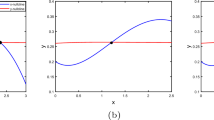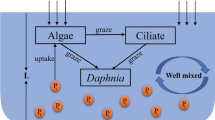Abstract
A model of extinction probability, based on the general theory of island biogeography [MacArthur and Wilson, 1967], is proposed for humans on oceanic islands; extinction probability is determined by island carrying capacity, frequency and amplitude of fluctuations in resources determining carrying capacity, and the net costs of contact and exchange between population units. The model predicts that extinction probability will determine island settlement patterns within an island group resulting in nonsettlement of islands with low carrying capacities and settlement of all islands with high carrying capacities. Data examined from the Marshall Islands tend to support the model. The model is extended to initial atoll colonization patterns. Possible requirements for initial settlement are suggested.
Similar content being viewed by others
References
Alkire, W. H. (1965). Lamotrek atoll and inter-island socio-economic ties. Illinois Studies in Anthropology No. 5. University of Illinois Press, Urbana.
Alkire, W. H. (1972).An Introduction to the Peoples and Cultures of Micronesia. Addison-Wesley, Reading, Mass.
Amerson, A. B. (1969). The ornithology of the Marshall and Gilbert Islands.Atoll Research Bulletin 127: 1–348.
Black, S. J. (1978). Polynesian outliers: A study in the survival of small populations. In Hodder, I. (ed.),Simulation Studies in Archaeology. Cambridge University Press, Cambridge.
Black, S. J. (1980). Demographic models and island colonization in the Pacific.New Zealand Journal of Archaeology 2: 51–64.
Brown, J. H., and Kodric-Brown, A. (1977). Turnover rates in insular biogeography: Effects of immigration on extinction.Ecology 58: 445–449.
Bryan, E. H. (1971).Guide to the place names in the Trust Territory of the Pacific Islands. Pacific Science Information Center, Bernice P. Bishop Museum, Honolulu, Hawaii.
Douglas, G. (1969). Draft check list of Pacific oceanic islands.Micronesica 5: 327–464.
Fosberg, F. R. (1956). Military geography of the Northern Marshalls. Intelligence Division, Headquarters U.S. Armed Forces, Far East, Tokyo.
Groube, L. M. (1971). Tonga, Lapita pottery and Polynesian origins.Journal of the Polynesian Society 80: 278–316.
Hainline, J. (1964). Human ecology in Micronesia: Determination of population size, dynamics and structure. Doctoral dissertation, University of California.
Jennings, J. D. (ed.) (1979).The Pre-history of Polynesia. Australian Nationai University Press, Canberra.
Jones, H. L., and Diamond, J. M. (1976). Short time base studies of turnover in breeding bird populations on California Channel islands.Condor 78: 526–549.
Jones, R. (1977). Man as an element of a continental fauna: The case of the sundering of the Bassian bridge. In Allen, J., Golsen, J., and Jones, R. (eds.),Sunda and Sahul: Prehistoric Studies in South East Asia, Melanesia and Australia. Academic Press, London.
Karr, J. R. (1982). Population variability and extinction in the avifauna of a tropical land bridge island.Ecology 63: 1975–1979.
Kiste, R. C. (1974).The Bikinians: A Study in Forced Migration. Cummings, Menlo Park, Calif.
Kunstader, P. (1972). Demography, ecology, social structure and settlement patterns. In Harrison, G. A., and Boyce, A. J. (eds).The Structure of Human Populations. Clarendon, Oxford.
Lampert, R. J. (1977). Kangaroo Island and the antiquity of Australians. In Wright, R. V. S. (ed.),Stone Tools as Cultural Markers: Change, Evolution and Complexity. Canberra, Australian Institute of Aboriginal Studies.
Lampert, R. (1981). The great Kartan mystery. Terra Australis No. 5. Department of Prehistory, Research School of Pacific Studies, Australian National University, Canberra.
Law, G. (1977). Genesis in Oceania.New Zealand Archaeology Association Newsletter 20: 86–106.
Leigh, E. G. (1975). Population fluctuations, community stability and environmental variability. In Cody, M. L., and Diamond, J. M. (eds.).Ecology and Evolution of Communities. Belknap Press, Cambridge, Mass.
Leigh, E. G. (1981) The average lifetime of a population in a varying environment.Journal of Theoretical Biology 90: 213–239.
Levinson, M., Ward, R. G. and Webb, J. W. (1973).The Settlement of Polynesia: A Computer Simulation. Australian National University Press, Canberra.
Lewis, D. (1972).We, the Navigators: The Ancient Art of Land Finding in the Pacific. Australian National University Press, Canberra.
MacArthur, R. H., and Wilson, E. O. (1967).The Theory of Island Biogeography. Princeton University Press, Princeton, N. J.
MacCluer, J. W., and Dyke, B. (1976). On minimum size of endogamous populations.Social Biology 23: 1–12.
McArthur, N. (1976). Computer simulations of small populations.Australian Archaeology 4: 53–57.
McArthur, N., Saunders, I., and Tweedie, R. (1976). Small population isolates: a micro simulation study.Journal of the Polynesian Society 85: 307–326.
Nason, J. D. (1975). The strength of the land: Community perception of population on Etal Atoll. In Caroll, V. (ed.),Pacific Atoll Populations. University of Hawaii Press, Honolulu.
Pielou, E. C. (1969).Introduction to Mathematical Ecology. Wiley Interscience, New York.
Terborgh, J., and Winter B. (1980). Some causes of extinction. In Soule, M. E., and Wilcox, B. A. (eds.),Conservation Biology. Sinauer, Sunderland, Mass.
U. S. Department of Commerce (1968).World Weather Records, 1951–1960, Vol. 6,Antarctica, Australia, Oceanic Islands and Ocean Weather Stations. Environmental Sciences Services Administration, Environmental Data Service, Washington, D. C.
Wiens, H. J. (1962).Atoll Environment and Ecology. Yale University Press, New Haven, Conn.
Williamson, I. and Sabath, M. D. (1982). Island population, land area, and climate: A case study of the Marshall Islands.Human Ecology 10: 71–84.
Author information
Authors and Affiliations
Additional information
Deceased.
Rights and permissions
About this article
Cite this article
Williamson, I., Sabath, M.D. Small population instability and island settlement patterns. Hum Ecol 12, 21–34 (1984). https://doi.org/10.1007/BF01531282
Issue Date:
DOI: https://doi.org/10.1007/BF01531282




